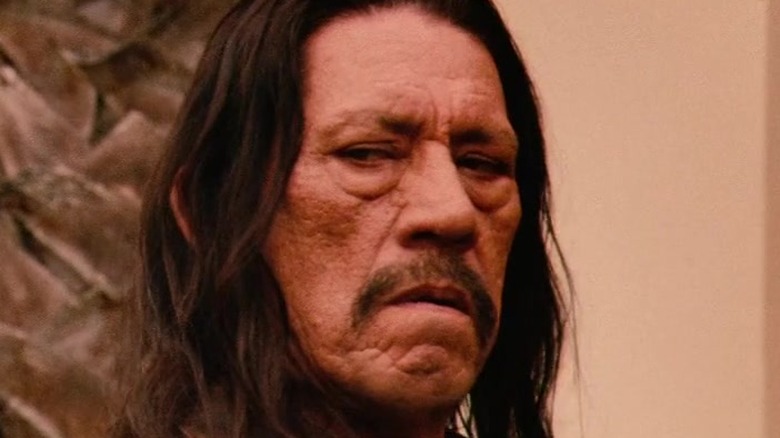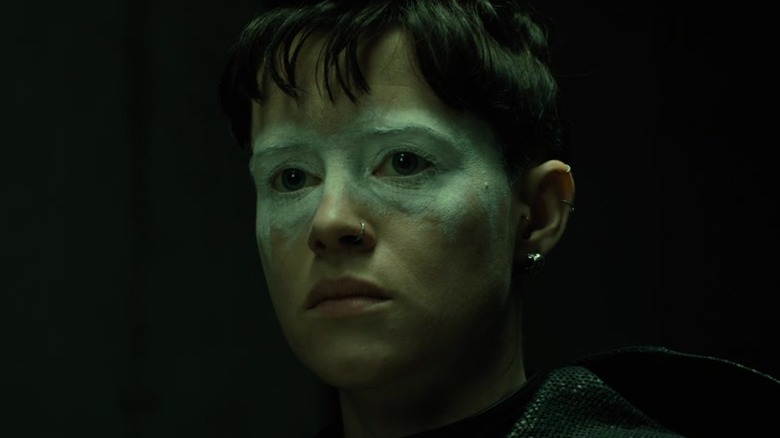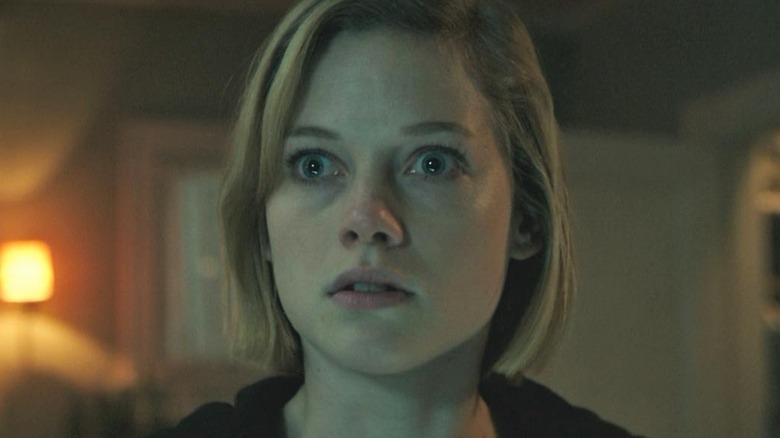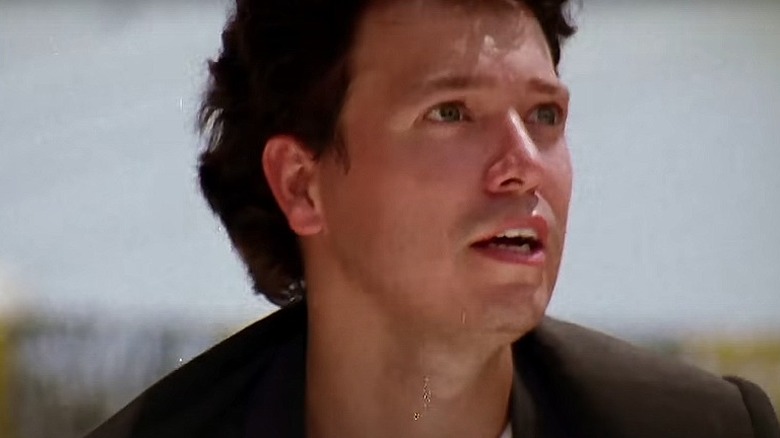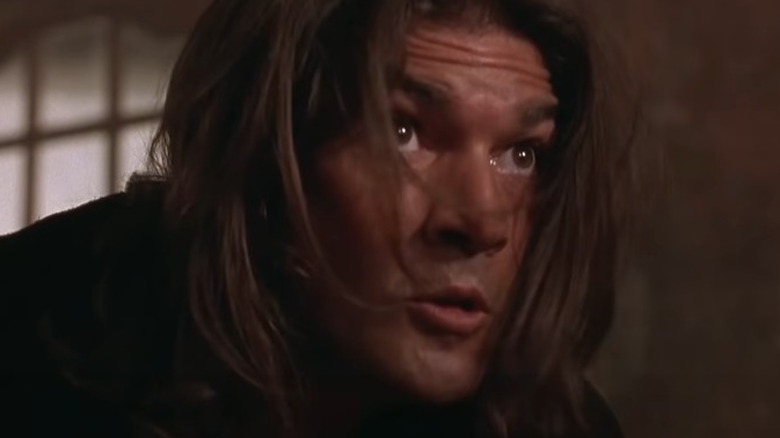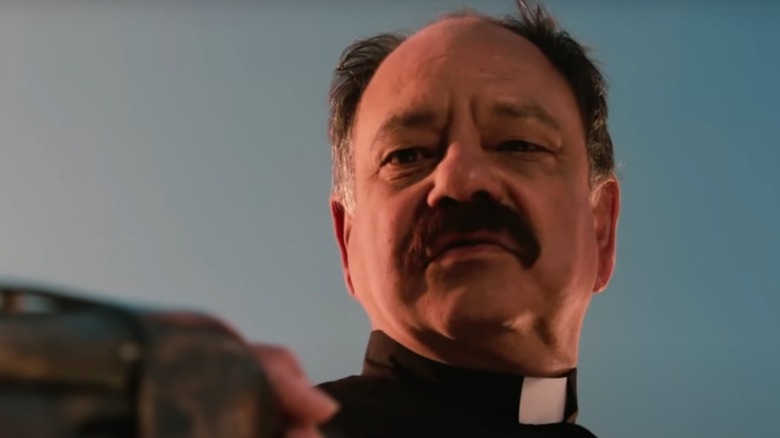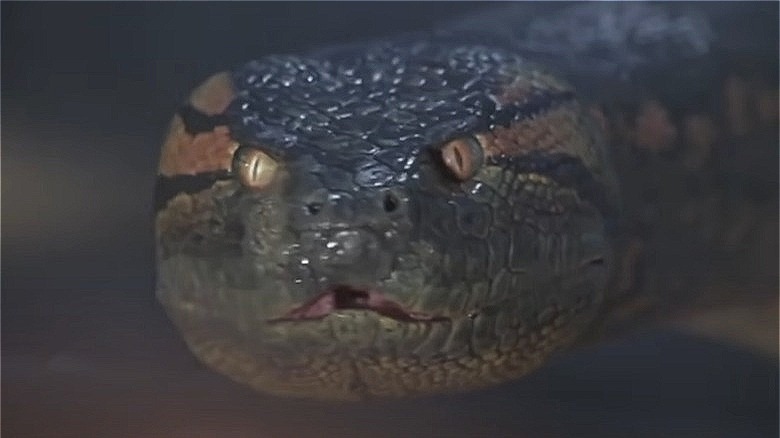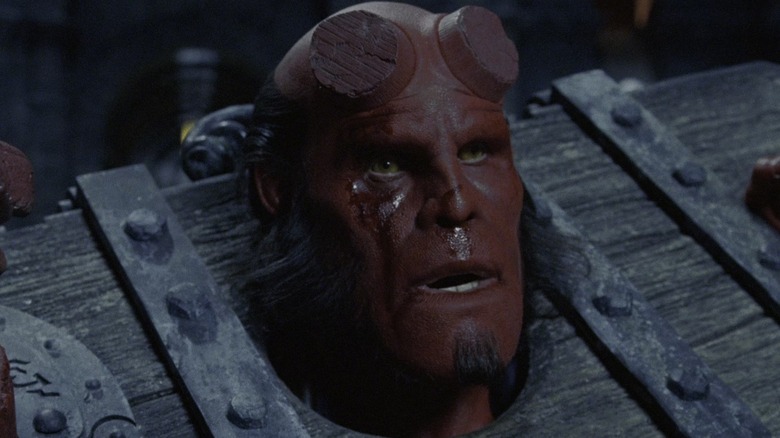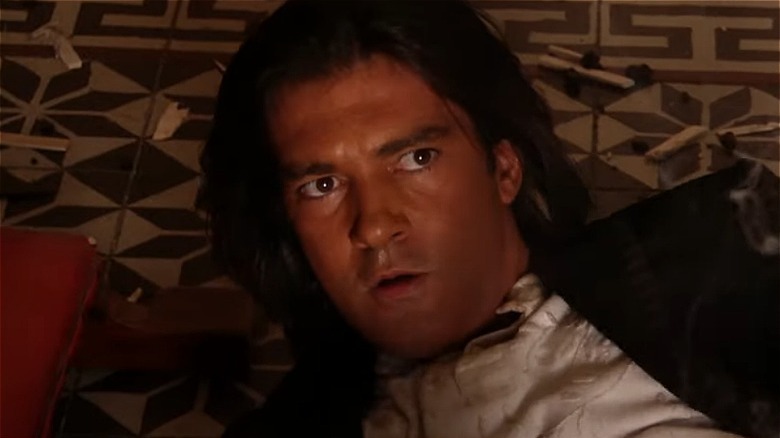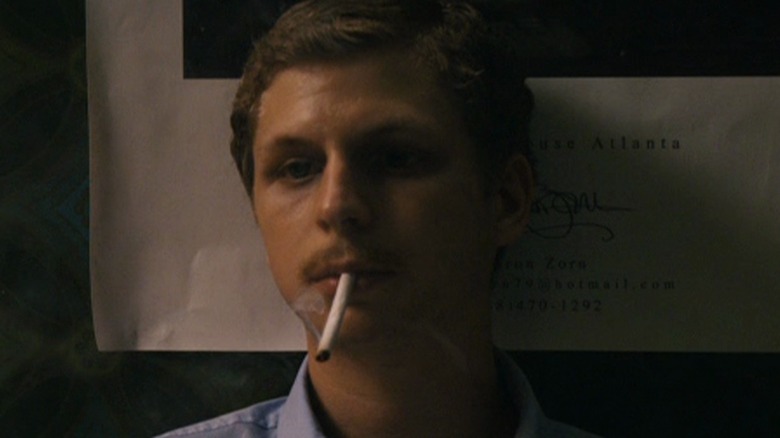Next Level Scenes From Films By Latinx Directors
This content was paid for by Sony and created by Looper.
"Latinx" describes a person born in a country or territory in Central America or South America (or to one or more parents from that region), collectively known as Latin America because its predominant language, Spanish, is derived from the ancient Latin tongue. Each year from August 15 to September 15, National Hispanic Heritage Month is officially celebrated in the United States, a way to honor, explore, and enjoy the contributions to American culture by residents and citizens of a Latinx background. Started in 1968 as Hispanic Heritage Week, it expanded into a month in 1988 by presidential decree, as seven days wasn't nearly enough time to recognize and celebrate the artistic achievements of Americans with a Latin American background.
Many of today's top film directors share a Latinx heritage, born or raised in Central America, South America, or the Caribbean, or brought up in the United States by first-generation immigrants from those countries. They've made a tremendous impact on the art and business of American movies. Here are some of the best scenes ever created and crafted by Latinx filmmakers.
The Girl in the Spider's Web
"The Girl with the Dragon Tattoo" books were a global publishing phenomenon, and the film adaptations are also a multinational affair. Based on the novel of the same name by Swedish writer David Lagercrantz (taking over for original, deceased author Stieg Larsson), "The Girl in the Spider's Web" stars English actor Claire Foy as hacker and vigilante justice dispatcher Lisbeth Salander under the direction of Uruguayan filmmaker Fede Alvarez.
This scene from "The Girl in the Spider's Web" is the movie's signature sequence, one confidently and expertly arranged by Alvarez, while also acting as the movie's thesis statement. It shows what motivates Lisbeth Sander and the kind of recompense she's capable of dishing out. Allowed entry into the home of a known domestic abuser by his wife, Lisbeth confronts the guy, traps him, and strings him up, leaving him upside down and finally sorry for what he did (especially after she digitally drains his bank accounts).
Don't Breathe
Prior to relaunching the Lisbeth Sander movie saga, South American writer-director Fede Alvarez honed his craft and earned a reputation as one of the world's most exciting up and coming filmmakers, writing and directing a remake of "Evil Dead" and performing the same creative tasks on his own movie, the compelling and original horror film "Don't Breathe."
Several of the big hallmarks of horror are present in this brief scene from "Don't Breathe," including an inscrutable and dangerous villain, lots of blood, unspeakable horror, and the revelation thereof. Repeat burglars Rocky and Alex enter the basement of the mysterious "Blind Man," where they're lunged at by a gagged, bound, and deeply distressed pregnant woman obviously being held against her will. Desperate to get out, and to also free this abused prisoner, the horror movie tension builds to an uncomfortable and almost intolerable level as the three try to flee the basement — and certain death.
El Mariachi
Texas-born child of Mexican emigres Robert Rodriguez served as the chief creative voice on his first feature film, "El Mariachi," credited as the movie's director, writer, producer, film editor, sound editor, cinematographer, and camera operator. Taking on so many jobs makes sense, as Rodriguez made the 1992 film on a budget of just over $7,000.
The plot of the film: A man known only as El Mariachi travels from town to town in northern Mexico, nobly and humbly seeking work as a musician. He carries little more than his guitar in a case, and he happens to arrive in a new place around the same time that a criminal busts out of jail...with a guitar case full of guns and an eye toward revenge against the drug lord who got him arrested. In an instance of high-stakes mistaken identity, the local bad guys mistake El Mariachi for the escaped convict, and they heavily pursue this stranger with the case in an exciting, on-foot chase sequence.
Desperado
After "El Mariachi" earned back nearly 300 times its budget, Hollywood noticed Mexican-American writer-director Robert Rodriguez, and he got a much bigger bag of cash (about $7 million) to bring the follow-up to the screen. In "Desperado," the second chapter of the planned trilogy, Antonio Banderas steps into the role of gunslinger El Mariachi, carrying his guitar case into a Mexican border town to do battle with the local drug gang that runs things.
In "Desperado," El Mariachi is no longer an innocent. He's been pulled into the world of Mexican gang violence, and he's actively seeking revenge against those who killed his beloved girlfriend. In the film's epic central action sequence in a low-rent bar, El Mariachi arouses suspicion because he's carrying a guitar case — harkening back to "El Mariachi," when a criminal was roaming around with a case loaded with weaponry. This time, El Mariachi's case has a guitar...along with a secret compartment that is full of guns, which fuel a dynamic, non-stop firearm battle. Bottles of booze explode, bullets nick at the wooden bar, and El Mariachi at one point throws a guy off of him and shoots him while he's still in the air. It's graphically violent, but masterfully made.
Machete
The 2010 one-man-army B-movie homage "Machete" came into existence in a most unusual way. It's the ultra-violent story of a former Mexican Federale out for revenge against the duplicitous former allies who set him up to take a fall after surviving an attack by a drug lord. "Machete" starred beloved and prolific tough-guy character actor Danny Trejo, reprising the role he played in a faux-trailer for a then-nonexistent movie called "Machete," a spinoff from Mexican-American filmmaker Robert Rodriguez kids sci-fi action movie series "Spy Kids."
There's something about the juxtaposition of very opposite things that make for fascinating visuals in a film scene. In this very violent but beautifully choreographed and photographed scene from Rodriguez, "Machete" villain Michael Booth, an evil businessman with a slew of assassins at his command, raids the church that serves as a stronghold for Machete's loyal brother Padre, a priest who executes a couple of hired guns before he's summarily crucified. Bright sunlight illuminates the sequence, leaking in from bullet holes and stained glass windows, showing off the religious imagery as well as framing the carnage left in the Booth vs. Padre battle.
Anaconda
Easily one of the creepiest and most unsettling monster movies from the 1990s, "Anaconda" is in part so frightening because it's about a beast that's mostly real — a massive, jungle-residing water snake that smothers and eats its human victims with ease. The 1997 film had a star-packed cast including Jon Voight, Ice Cube, Owen Wilson, and Jennifer Lopez, and it was helmed by Peruvian director Luis Llosa, calling the shots on his third major Hollywood feature, having developed his skills directing hundreds of episodic of South American episodic television.
Deep in the jungle in the Amazon River-adjacent rainforest, a documentary crew in search of a isolated indigenous tribe are rerouted by Paul, a snake hunter who needs their help hunting an especially large and angry anaconda. While sailing down the river, things are a little too quiet, which in the world of horror movies means a jump scare is around the corner. Llosa obliges, as the predatory anaconda of "Anaconda" attempts to make a meal of the film crew. One tech, Denise, falls in, and colleague Gary jumps in after. RIP Gary, who suffers a vicious but quick death via giant snake.
Hellboy
Years before he won two Academy Awards, Mexico-born writer-director Guillermo del Toro was pushing the boundaries of genre film, proving that horror, sci-fi, and comic book movies could be as beautifully and expertly crafted as more reserved and less populist cinematic styles. In 2004, del Toro wrote and directed "Hellboy," the first big-screen film starring the Dark Horse Comics character, a horned, red-skinned demon (Ron Perlman) whisked away from the Nazis as a baby and trained to become a vanquisher of evil forces.
The climactic scene of "Hellboy" showed the world not only what del Toro could do, but also that movies based on comic books could be artful and well articulated, beyond their inherent crowd-pleasing entertainment value. Set in a Russian mausoleum belonging to the legendary Rasputin, Hellboy finds his true love Liz and their ally Myers — but they're knocked out by the reborn Rasputin and fellow villain Haupstein. After Rasputin sucks out the soul of Liz, laying in sacrifice on a grand altar, Hellboy digs deep to find his true power, breaking out of restraining stocks, rips off one of his own powerful horns, and stabs Rasputin with it.
Once Upon a Time in Mexico
Each time Robert Rodriguez made another movie about El Mariachi, the stakes and production budget grew exponentially. "Once Upon a Time in Mexico," which saw Johnny Depp join "Desperado" stars Antonio Banderas and Salma Hayek, had $29 million to work with, almost guaranteeing some spectacular scenes bringing the director's vision to life.
In this epic scene from "Once Upon a Time in Mexico," El Mariachi (Antonio Banderas) enters a towering, gorgeous cathedral, with lit candles flanking a majestic altar. He's notably without his guitar case, only his guitar, as he enters the confession booth, dramatically and compellingly seeking to be absolved by his higher power from the great sins he's about to commit. The little room also serves as a secret meeting place for El Mariachi and the quirky, disguised CIA agent Sands (Depp), his handler, to receive further instructions. But because this is part of Robert Rodriguez's trilogy of El Mariachi films, there's a lot of elegant gunplay that's staged and filmed with both the pomp and precision of an old fashioned musical number.
Youth in Revolt
Born in the Spanish-speaking U.S. territory of Puerto Rico, writer-director Miguel Arteta came up in American television and indie film, directing episodes of "Freaks and Geeks" and "Homicide" before moving up to well-received and funny big-screen character studies, including the quirky 2009 Jekyll-and-Hyde coming-of-age teen comedy "Youth in Revolt."
Nick Twisp (Michael Cera) is an extremely mild, mannered, and mild-mannered teen who spends most of his time alone in his room, listening to old records and avoiding his mother and her boyfriend. Tired of being a human doormat, this pivotal seen in "Youth in Revolt" depicts Nick forcing himself to become a man of action by creating a supplemental identity, an alter ego named Francois Dillinger — and he will be the one, technically, who makes Nick to be more assertive. After hearing some bad news from a police officer that devastates his mother, Nick returns to his room to find Francois, cool, elegant, direct, and sporting a suave pencil-thin mustache, destroying his records, a symbol of the teen's ineffectuality. He encourages Nick to act out, to rise up, to go after what he wants. The adoption of the Francois persona is complete when, in rapid succession, Nick flushes his mother's jewelry town the toilet, cuts up her intimates, and paints a nasty phrase on her trailer.
